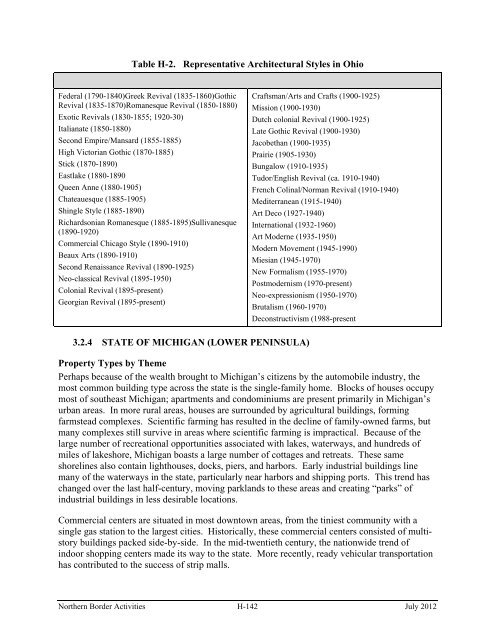Appendix H - Historical Archaeological and ... - CBP.gov
Appendix H - Historical Archaeological and ... - CBP.gov
Appendix H - Historical Archaeological and ... - CBP.gov
Create successful ePaper yourself
Turn your PDF publications into a flip-book with our unique Google optimized e-Paper software.
Table H-2. Representative Architectural Styles in Ohio<br />
Federal (1790-1840)Greek Revival (1835-1860)Gothic<br />
Revival (1835-1870)Romanesque Revival (1850-1880)<br />
Exotic Revivals (1830-1855; 1920-30)<br />
Italianate (1850-1880)<br />
Second Empire/Mansard (1855-1885)<br />
High Victorian Gothic (1870-1885)<br />
Stick (1870-1890)<br />
Eastlake (1880-1890<br />
Queen Anne (1880-1905)<br />
Chateauesque (1885-1905)<br />
Shingle Style (1885-1890)<br />
Richardsonian Romanesque (1885-1895)Sullivanesque<br />
(1890-1920)<br />
Commercial Chicago Style (1890-1910)<br />
Beaux Arts (1890-1910)<br />
Second Renaissance Revival (1890-1925)<br />
Neo-classical Revival (1895-1950)<br />
Colonial Revival (1895-present)<br />
Georgian Revival (1895-present)<br />
Craftsman/Arts <strong>and</strong> Crafts (1900-1925)<br />
Mission (1900-1930)<br />
Dutch colonial Revival (1900-1925)<br />
Late Gothic Revival (1900-1930)<br />
Jacobethan (1900-1935)<br />
Prairie (1905-1930)<br />
Bungalow (1910-1935)<br />
Tudor/English Revival (ca. 1910-1940)<br />
French Colinal/Norman Revival (1910-1940)<br />
Mediterranean (1915-1940)<br />
Art Deco (1927-1940)<br />
International (1932-1960)<br />
Art Moderne (1935-1950)<br />
Modern Movement (1945-1990)<br />
Miesian (1945-1970)<br />
New Formalism (1955-1970)<br />
Postmodernism (1970-present)<br />
Neo-expressionism (1950-1970)<br />
Brutalism (1960-1970)<br />
Deconstructivism (1988-present<br />
3.2.4 STATE OF MICHIGAN (LOWER PENINSULA)<br />
Property Types by Theme<br />
Perhaps because of the wealth brought to Michigan’s citizens by the automobile industry, the<br />
most common building type across the state is the single-family home. Blocks of houses occupy<br />
most of southeast Michigan; apartments <strong>and</strong> condominiums are present primarily in Michigan’s<br />
urban areas. In more rural areas, houses are surrounded by agricultural buildings, forming<br />
farmstead complexes. Scientific farming has resulted in the decline of family-owned farms, but<br />
many complexes still survive in areas where scientific farming is impractical. Because of the<br />
large number of recreational opportunities associated with lakes, waterways, <strong>and</strong> hundreds of<br />
miles of lakeshore, Michigan boasts a large number of cottages <strong>and</strong> retreats. These same<br />
shorelines also contain lighthouses, docks, piers, <strong>and</strong> harbors. Early industrial buildings line<br />
many of the waterways in the state, particularly near harbors <strong>and</strong> shipping ports. This trend has<br />
changed over the last half-century, moving parkl<strong>and</strong>s to these areas <strong>and</strong> creating “parks” of<br />
industrial buildings in less desirable locations.<br />
Commercial centers are situated in most downtown areas, from the tiniest community with a<br />
single gas station to the largest cities. <strong>Historical</strong>ly, these commercial centers consisted of multistory<br />
buildings packed side-by-side. In the mid-twentieth century, the nationwide trend of<br />
indoor shopping centers made its way to the state. More recently, ready vehicular transportation<br />
has contributed to the success of strip malls.<br />
Northern Border Activities H-142 July 2012
















